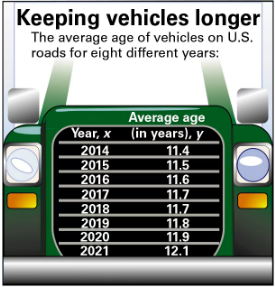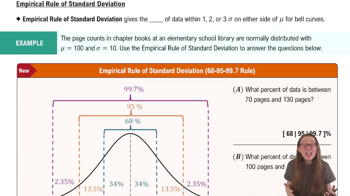In the context of regression analysis, what is a residual (), and what does it indicate when a residual is positive ()?
Table of contents
- 1. Intro to Stats and Collecting Data1h 14m
- 2. Describing Data with Tables and Graphs1h 55m
- 3. Describing Data Numerically2h 5m
- 4. Probability2h 16m
- 5. Binomial Distribution & Discrete Random Variables3h 6m
- 6. Normal Distribution and Continuous Random Variables2h 11m
- 7. Sampling Distributions & Confidence Intervals: Mean3h 23m
- Sampling Distribution of the Sample Mean and Central Limit Theorem19m
- Distribution of Sample Mean - Excel23m
- Introduction to Confidence Intervals15m
- Confidence Intervals for Population Mean1h 18m
- Determining the Minimum Sample Size Required12m
- Finding Probabilities and T Critical Values - Excel28m
- Confidence Intervals for Population Means - Excel25m
- 8. Sampling Distributions & Confidence Intervals: Proportion1h 25m
- 9. Hypothesis Testing for One Sample3h 57m
- 10. Hypothesis Testing for Two Samples4h 50m
- Two Proportions1h 13m
- Two Proportions Hypothesis Test - Excel28m
- Two Means - Unknown, Unequal Variance1h 3m
- Two Means - Unknown Variances Hypothesis Test - Excel12m
- Two Means - Unknown, Equal Variance15m
- Two Means - Unknown, Equal Variances Hypothesis Test - Excel9m
- Two Means - Known Variance12m
- Two Means - Sigma Known Hypothesis Test - Excel21m
- Two Means - Matched Pairs (Dependent Samples)42m
- Matched Pairs Hypothesis Test - Excel12m
- 11. Correlation1h 24m
- 12. Regression1h 50m
- 13. Chi-Square Tests & Goodness of Fit2h 21m
- 14. ANOVA1h 57m
12. Regression
Residuals
Problem 9.3.34
Textbook Question
"Old Vehicles In Exercises 31–34, use the figure shown at the left.

Error of Estimate Find the standard error of estimate Se and interpret the results."
 Verified step by step guidance
Verified step by step guidance1
Step 1: Understand the problem. The goal is to calculate the standard error of estimate (Se), which measures the accuracy of predictions made by a regression line. The data provided includes the years (x) and the average age of vehicles (y).
Step 2: Write down the formula for the standard error of estimate: , where y represents the observed values, ŷ represents the predicted values from the regression line, and n is the number of data points.
Step 3: Perform a linear regression analysis to find the regression equation. Use the given data points to calculate the slope (b) and y-intercept (a) of the regression line using the formulas: and , where x̄ and ȳ are the means of x and y, respectively.
Step 4: Use the regression equation (ŷ = a + b * x) to calculate the predicted values (ŷ) for each year in the dataset. Then, compute the squared differences between the observed values (y) and the predicted values (ŷ), i.e., .
Step 5: Sum up all the squared differences, divide by (n - 2), and take the square root to find Se. Interpret the result: A smaller Se indicates that the regression line predicts the data more accurately, while a larger Se suggests greater variability in the predictions.
 Verified video answer for a similar problem:
Verified video answer for a similar problem:This video solution was recommended by our tutors as helpful for the problem above
Video duration:
3mPlay a video:
Was this helpful?
Key Concepts
Here are the essential concepts you must grasp in order to answer the question correctly.
Standard Error of Estimate (Se)
The Standard Error of Estimate (Se) measures the accuracy of predictions made by a regression model. It quantifies the average distance that the observed values fall from the regression line. A smaller Se indicates a better fit of the model to the data, meaning predictions are closer to actual values, while a larger Se suggests more variability and less reliability in predictions.
Recommended video:
Guided course

Calculating Standard Deviation
Regression Analysis
Regression analysis is a statistical method used to examine the relationship between two or more variables. In this context, it helps to understand how the average age of vehicles (dependent variable) changes over the years (independent variable). By fitting a regression line to the data, we can make predictions and assess trends in vehicle age over time.
Recommended video:
Guided course

Intro to Least Squares Regression
Interpretation of Results
Interpreting results in statistics involves understanding what the calculated values mean in the context of the data. For the standard error of estimate, this means assessing how well the regression model predicts the average age of vehicles. A clear interpretation helps in making informed decisions based on the statistical analysis, such as identifying trends in vehicle longevity.
Recommended video:

Empirical Rule of Standard Deviation and Range Rule of Thumb

 7:38m
7:38mWatch next
Master Residuals and Residual Plots with a bite sized video explanation from Patrick
Start learningRelated Videos
Related Practice
Multiple Choice
14
views
